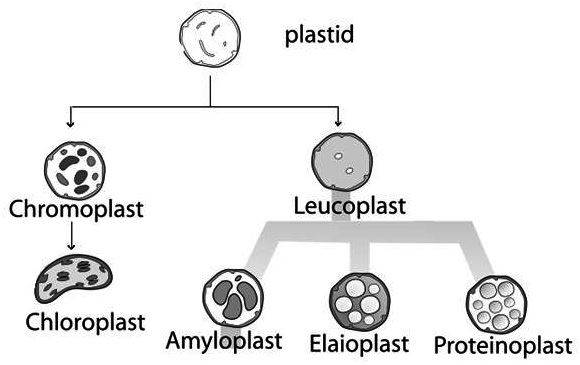Components of a Cell – Plastids
The term Plastid is derived from the Greek word, plastos that means formed or shaped-plastids are a key dual-membrane organelle found, amidst others, in the cells of algae and plants. Plastids are the location of manufacturing and storage of vital chemical compounds that are used by the cell. They frequently hold pigments that are used in the process of photosynthesis, and the varieties of pigments existing can alter or regulate the cell’s color. They have a mutual source and hold a dual-stranded DNA molecule that is spherical, similar to that of prokaryotes.
Diagram of Plastids
Those plastids that hold pigments can perform the process of photosynthesis. Plastids can furthermore stock produces like starch and can process terrenes and fatty acids, which can be used for generating energy and as a raw substance for the processing of other particles. For instance, the components of the plant cuticle and its epicuticular wax are created by the epidermal cells from palmitic acid, which is manufactured in the chloroplasts of the mesophyll tissue. All plastidsare derivatives of proplastids, which are existent in the meristematic sections of the plant. Proplastids and new chloroplasts normally increase their number by binary fission, but further developed chloroplasts too have this capability.
In plants, plastids may be segregated into numerous forms, which is dependent on what purpose they have in the cell. Plastids when remained undifferentiated (proplastids) may develop into any of the subsequent variations:
Chloroplasts Green Plastids: The chloroplasts are perhaps the best known of the plastids. These are accountable for photosynthesis. The chloroplast is jam-packed with thylakoids, which is where photosynthesis occurs, and chlorophyll.
Chromoplasts Colored Plastids: All plastids comprising of diverse colored pigments are categorized under chromoplasts, of which green ones are called chloroplasts. Subject to the prevailing pigments existent in plastids, they are additionally categorized into Rhodoplasts rich in red pigment i.e. phycoerythrin. Phaeoplasts and Xanthoplasts yellow pigments i.e. xanthophylls, carotinoids. Along with the above pigments phycocyanin and other pigments are also present in other colored plastids.
Gerontoplasts: used to regulate the disassembling of the photosynthetic contraption throughout senescence.
Leucoplasts colorless plastids: Neutral plastids that originate in storage, parenchyma and other colorless tissues are designated as leucoplasts. Many of them perform as storing organelles. Grounded on the type of material they stock they are additionally categorized into amyloplasts. If these types of leucoplasts are exposed to sunshine they will be converted into colored plastids, which proposes that these plastids have preserved all the genetic potentiality to mature and execute photosynthesis.
Amyloplasts: used for storing starch and to become aware of gravity
Elaioplasts: used for putting away fat.
Proteinoplasts: used for putting away and transforming protein.
Tannosomes: used for manufacturing and fabricating polyphenols and tannins.
In plants, plastids may be categorized into several sections, based upon which purpose they need to serve in the cell. But at the end of the day, the plastids are largely categorized into two key types to be precise chromoplasts and leucoplasts.
